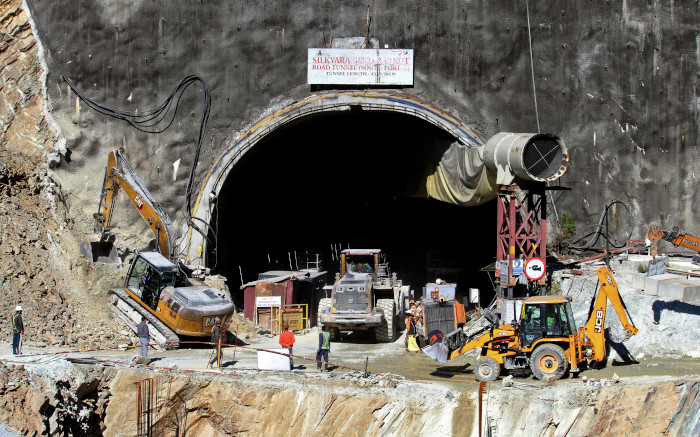
Ambulances moved toward the mouth of the tunnel entrance, preparing to receive the men trapped since part of the tunnel under construction collapsed in the Himalayan state of Uttarakhand.
Rescue workers stand at the entrance of the road tunnel under construction, days after it collapsed in Uttarkashi district of India’s Uttarakhand state on November 18, 2023. Indian rescuers said on November 18 they had suspended efforts to reach 41 men trapped in a collapsed road tunnel after a cracking sound triggered a “panic situation” over the possibility of another collapse. Image: AFP
SILKYARA TUNNEL – Indian rescuers were close to extricating 41 men from a collapsed road tunnel on Tuesday after laying the final section of pipe – the culmination of a marathon 17-day operation.
Ambulances moved toward the mouth of the tunnel entrance, preparing to receive the men trapped since part of the tunnel under construction collapsed in the Himalayan state of Uttarakhand.
“The work of laying pipes in the tunnel to take out the workers has been completed,” said Uttarakhand state Chief Minister Pushkar Singh Dhami, adding that they would be brought out of the tunnel “soon”.
Photos on social media showed rescue teams smiling and showing victory signs as drilling ended through the tons of earth, concrete and rubble that had blocked workers’ escape route.
Special wheeled stretchers were equipped to pull the exhausted men out through 57 meters (187 feet) of steel pipes.
“We are grateful to God and the rescuers who worked hard to save them,” Naiyer Ahmad, whose younger brother Sabah Ahmad is among the trapped workers and has been camping at the site for over two weeks, told AFP.
Sudhansu Shah, who has also been camping outside waiting for his younger brother Sonu Shah since shortly after the tunnel collapsed on November 12, said relatives had started celebrating.
“We’re really hopeful and happy,” he said.
“Effort and Sacrifice”
Dhami praised the “prayers of tens of millions of compatriots and the tireless work of all rescue teams involved in the rescue operation.”
The workers’ health was “good” but a team of medics at a field hospital were on the scene immediately after they were removed, he added.
Previous hopes of reaching the men have been dashed by falling debris and the failure of several drilling machines, and the government has repeatedly warned of the “challenging Himalayan terrain.”
After repeated setbacks in the operation, military engineers and experienced miners excavated the final section by hand using the so-called “rat hole” technique, with a three-person team working on the rock face in a metal pipe just wide enough for someone to squeeze through.
Indian billionaire Anand Mahindra paid tribute to the men on the rock face who squeezed into the narrow pipe to clear the rocks by hand.
“After all the sophisticated drilling equipment, it is the humble ‘rat hole miners’ who are making the decisive breakthrough,” Mahindra said on X, formerly Twitter.
“It’s a heartwarming reminder that at the end of the day, heroism is most often a case of individual effort and sacrifice.”
‘PLAY CRICKET’
Last week, engineers working to drive a metal pipe horizontally through 57 meters of rock and concrete encountered metal beams and construction vehicles buried in the rubble, destroying a giant earth boring machine.
Rescuers used an overheated plasma cutter to cut through metal bars that continued to impede progress.
In addition, a separate vertical shaft was constructed from the wooded hill above the tunnel, extending more than half of the 89 meters needed to reach the stranded men, a risky route in an area that has already collapsed.
The digging, blasting and drilling work also took place on the other side of the road tunnel, a much longer third stretch estimated at around 480 meters.
Last week, the workers were seen alive for the first time as they looked into the lens of an endoscopic camera sent by rescuers through a thin tube that carries air, food, water and electricity.
Even though they are trapped, the workers have plenty of space in the tunnel: the area inside is 8.5 meters high and stretches about two kilometers long.
Arnold Dix, president of the International Tunneling and Underground Space Association, which is advising on the rescue at the site, told reporters the men were in good spirits and he had heard they were “playing cricket.”






Recent Comments